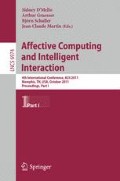Abstract
Impairments in social communication skills are thought to be core deficits in children with autism spectrum disorder (ASD). In recent years, several assistive technologies, particularly Virtual Reality (VR), have been investigated to promote social interactions in this population. It is well-known that these children demonstrate atypical viewing patterns during social interactions and thus monitoring eye-gaze can be valuable to design intervention strategies. However, presently available VR-based systems are designed to chain learning via aspects of one’s performance only permitting limited degree of individualization. Given the promise of VR-based social interaction and the usefulness of monitoring eye-gaze in real-time, a novel VR-based dynamic eye-tracking system is developed in this work. The developed system was tested through a small usability study with four adolescents with ASD. The results indicate the potential of the system to promote improved social task performance along with socially-appropriate mechanisms during VR-based social conversation tasks.
Access this chapter
Tax calculation will be finalised at checkout
Purchases are for personal use only
Preview
Unable to display preview. Download preview PDF.
References
APA.: Diagnostic and statistical manual of mental disorders: DSM-IV-TR. American Psychiatric Association, Washington, DC (2000)
Kanner, L.: Autistic disturbances of affective contact. Nervous Child 2, 217–250 (1943)
Wieder, S., Greenspan, S.: Can Children with Autism Master the Core Deficits and Be-come Empathetic, Creative, and Reflective? The J. of Dev. and Learning Dis. 9 (2005)
Trepagnier, C.Y., Sebrechts, M.M., Finkelmeyer, A., Stewart, W., Woodford, J., Coleman, M.: Simulating social interaction to address deficits of autistic spectrum disorder in children. Cyberpsych. Behav. 9(2), 213–217 (2006)
Goodwin, M.S.: Enhancing and accelerating the pace of Autism Research and Treatment: The promise of developing Innovative Technology. Focus on Autism and other Developmental Disabilities 23, 125–128 (2008)
Strickland, D.: Virtual reality for the treatment of autism. In: Riva, G. (ed.) Virtual Reality in Neuropsychophysiology, pp. 81–86. IOS Press, Amsterdam (1997)
Parsons, S., Mitchell, P., Leonard, A.: The use and understanding of virtual environments by adolescents with autistic spectrum disorders. J. Autism. Dev. Disord. 34(4), 449–466 (2004)
Tartaro, A., Cassell, J.: Using Virtual Peer Technology as an Intervention for Children with Autism. In: Lazar, J. (ed.) Towards Universal Usability: Designing Computer Interfaces for Diverse User Populations, UK. John Wiley and Sons, Chichester (2007)
Wilms, M., Schilbach, L., Pfeiffer, U., Bente, G., Fink, G.R., Vogeley, K.: It’s in your eyes using gaze-contingent stimuli to create truly interactive paradigms for social cognitive and affective neuroscience. Social Cognitive and Affective Neuroscience 5(1), 98–107 (2010)
NRC: Educating children with autism. National Academy Press, Washington, DC (2001)
Anderson, C.J., Colombo, J., Shaddy, D.J.: Visual Scanning and Pupillary Responses in Young Children with Autism Spectrum Disorder. J. of Clinical and Experimental Neuro-psychology 28, 1238–1256 (2006)
Jensen, B., Keehn, B., Brenner, L., Marshall, S.P., Lincoln, A.J., Müller, R.A.: In-creased Eye-Blink Rate in Autism Spectrum Disorder May Reflect Dopaminergic Abnormalities. Intl. Society for Autism Research, Poster Presentation (2009)
Ruble, L.A., Robson, D.M.: Individual and environmental determinants of engagement in autism. J. of Aut. and Dev. Dis. 37(8), 1457–1468 (2006)
Booth, T.: Sequential Machines and Automata Theory. John Wiley and Sons, New York (1967)
Dunn, L.M., Dunn, L.M.: PPVT-III: Peabody Picture Vocabulary Test. Circle Pines. American Guidance Service, Minnesota (1997)
Constantino, J.N.: The Social Responsiveness Scale. W. Psych. Serv., California (2002)
Rutter, M., Bailey, A., Berument, S., Lord, C., Pickles, A.: Social Communication Questionnaire. Western Psychological Services, Los Angeles (2003a)
Lord, C., Risi, S., Lambrecht, L., Cook, E.H., Leventhal, B.L., DiLavore, P.C., Pickles, A., Rutter, M.: The Autism diagnostic observation schedule-generic: A standard measure of social and communication deficits associated with the spectrum of autism. J. of Autism and Dev. Dis. 30(3), 205–223 (2000)
Rutter, M., Couteur, A., Le, L.C.: Autism diagnostic interview revised WPS edition manual. W. Psych. Serv., Los Angeles (2003b)
Author information
Authors and Affiliations
Editor information
Editors and Affiliations
Rights and permissions
Copyright information
© 2011 Springer-Verlag Berlin Heidelberg
About this paper
Cite this paper
Lahiri, U., Bekele, E., Dohrmann, E., Warren, Z., Sarkar, N. (2011). Design of a Virtual Reality Based Adaptive Response Technology for Children with Autism Spectrum Disorder. In: D’Mello, S., Graesser, A., Schuller, B., Martin, JC. (eds) Affective Computing and Intelligent Interaction. ACII 2011. Lecture Notes in Computer Science, vol 6974. Springer, Berlin, Heidelberg. https://doi.org/10.1007/978-3-642-24600-5_20
Download citation
DOI: https://doi.org/10.1007/978-3-642-24600-5_20
Publisher Name: Springer, Berlin, Heidelberg
Print ISBN: 978-3-642-24599-2
Online ISBN: 978-3-642-24600-5
eBook Packages: Computer ScienceComputer Science (R0)

